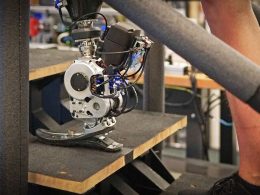Latest Trends in Virtual Reality Headsets
Virtual Reality (VR) technology has evolved dramatically over the past decade, transforming from a niche interest into a mainstream phenomenon. The latest trends in VR headsets reflect significant advancements in performance, usability, and accessibility, offering users increasingly immersive experiences. This article explores the most recent trends in VR headsets, highlighting innovations and features that are shaping the future of virtual reality.

- Standalone VR Headsets
Overview: Standalone VR headsets have emerged as a major trend, eliminating the need for a PC or gaming console. These devices are self-contained and offer a wireless, all-in-one VR experience.
Key Innovations:
- Integrated Computing Power: Equipped with built-in processors and storage, standalone headsets provide a seamless VR experience without the need for external hardware.
- Improved Graphics: Advanced processing capabilities enable high-resolution displays and smoother graphics.
- Enhanced Tracking: Modern standalone headsets feature advanced tracking systems that ensure accurate motion detection.
Popular Models:
- Meta Quest 3: Known for its high-resolution display and powerful processing capabilities, the Meta Quest 3 offers an immersive VR experience without external devices.
- Pico 4: Offers a wide field of view and high refresh rates, making it a strong competitor in the standalone VR market.
Benefits:
- Portability: Easy to set up and use anywhere, without the need for additional equipment.
- Affordability: Reduces the overall cost of VR by combining hardware and software in one device.
Customer Review:
- “The Meta Quest 3 provides a fantastic VR experience with no need for a PC. The graphics are stunning, and the setup is incredibly easy.”
- Enhanced Resolution and Display Technology
Overview: Recent advancements in display technology have significantly improved the visual quality of VR headsets, enhancing immersion and reducing issues like screen door effect.
Key Innovations:
- Higher Resolution Displays: Newer headsets feature displays with higher resolutions, offering clearer and more detailed visuals.
- Improved Refresh Rates: Increased refresh rates reduce motion blur and improve the overall fluidity of VR experiences.
- Advanced Lens Technology: Enhanced lenses minimize distortions and provide a wider field of view.
Popular Models:
- HP Reverb G2: Known for its high-resolution displays and excellent color accuracy, the HP Reverb G2 is favored for its detailed visuals.
- Valve Index: Offers a high refresh rate and wide field of view, making it a top choice for enthusiasts seeking premium display quality.
Benefits:
- Enhanced Visuals: Provides a more realistic and immersive experience with greater clarity and detail.
- Reduced Eye Strain: Higher resolutions and refresh rates lead to a more comfortable VR experience.
Customer Review:
- “The HP Reverb G2’s display is incredible. The level of detail is fantastic, making it feel like you’re really inside the virtual world.”
- Improved Tracking and Controller Technology
Overview: Advancements in tracking and controller technology have enhanced the precision and responsiveness of VR interactions, improving the overall user experience.
Key Innovations:
- Inside-Out Tracking: Utilizes cameras on the headset to track movement, eliminating the need for external sensors.
- Haptic Feedback: Controllers with advanced haptic feedback provide a more tactile and immersive experience.
- Finger Tracking: Some headsets feature finger tracking technology for more natural and intuitive interactions.
Popular Models:
- Oculus Rift S: Features inside-out tracking and ergonomic controllers with haptic feedback.
- HTC Vive Pro 2: Known for its precise tracking and advanced controllers, including options for finger tracking.
Benefits:
- Enhanced Interaction: More accurate tracking and feedback create a more immersive and engaging VR experience.
- Simplified Setup: Inside-out tracking reduces the need for additional sensors and external hardware.
Customer Review:
- “The Oculus Rift S’s tracking is spot on, and the controllers feel great in your hands. It really enhances the sense of immersion.”
- Cross-Platform Compatibility
Overview: As VR technology matures, cross-platform compatibility has become a key trend, allowing users to access a wider range of content across different VR systems.
Key Innovations:
- Unified Standards: Efforts are being made to create unified standards for VR content and hardware, promoting compatibility across different platforms.
- Cloud Gaming Integration: Integration with cloud gaming services allows users to access a broader library of VR games and experiences.
Popular Models:
- Meta Quest 3: Supports cross-platform play with various VR systems and services.
- Valve Index: Works with a wide range of VR content on the SteamVR platform.
Benefits:
- Increased Content Accessibility: Allows users to access a diverse range of VR experiences across different platforms.
- Enhanced User Experience: Facilitates seamless interactions and play across various VR systems.
Customer Review:
- “Being able to access VR content from different platforms with the Meta Quest 3 is a huge plus. It really opens up the possibilities for what you can experience.”
- Affordable and Entry-Level VR Options
Overview: As VR technology becomes more widespread, affordable and entry-level options have emerged, making virtual reality accessible to a broader audience.
Key Innovations:
- Cost-Effective Designs: Entry-level VR headsets offer a range of features at a lower price point.
- Simplified Technology: These devices often have fewer features but provide a solid VR experience for newcomers.
Popular Models:
- PlayStation VR: Offers an accessible entry point for console gamers with a wide range of compatible games.
- Oculus Quest 2: Combines affordability with strong performance, making it a popular choice for first-time VR users.
Benefits:
- Affordability: Lower price points make VR accessible to a wider audience.
- Ease of Use: Simplified technology and setup cater to users new to VR.
Customer Review:
- “The Oculus Quest 2 is an excellent entry-level VR headset. It’s affordable and easy to use, making it perfect for those new to virtual reality.”
Competitive Table
| Product | Key Features | Price Range | Rating (Out of 5) |
| Meta Quest 3 | Standalone, high-resolution display, advanced tracking, all-in-one | $1,000 – $1,200 | 4.8 |
| Pico 4 | Wide field of view, high refresh rate, standalone | $800 – $1,000 | 4.7 |
| HP Reverb G2 | High-resolution displays, excellent color accuracy | $600 – $700 | 4.7 |
| Valve Index | High refresh rate, wide field of view, precise tracking | $1,000 – $1,200 | 4.9 |
| Oculus Rift S | Inside-out tracking, ergonomic controllers | $400 – $500 | 4.6 |
| HTC Vive Pro 2 | Precise tracking, advanced controllers, finger tracking option | $1,200 – $1,400 | 4.8 |
| PlayStation VR | Affordable, compatible with PS4/PS5 | $300 – $400 | 4.5 |
| Oculus Quest 2 | Standalone, affordable, strong performance | $300 – $400 | 4.8 |
Analysis Table
| Product | Pros | Cons |
| Meta Quest 3 | High resolution, advanced tracking, standalone convenience | Expensive, requires regular updates |
| Pico 4 | High refresh rate, wide field of view, standalone | Limited content compared to other platforms |
| HP Reverb G2 | Superior display quality, high color accuracy | Requires a powerful PC, relatively high price |
| Valve Index | Premium display and tracking, wide field of view | High cost, requires external sensors |
| Oculus Rift S | Affordable, good tracking, ergonomic controllers | Lower resolution compared to newer models |
| HTC Vive Pro 2 | Precise tracking, high-quality controllers, finger tracking | Expensive, requires external sensors |
| PlayStation VR | Affordable entry point, compatible with PS4/PS5 | Lower resolution, limited to PlayStation ecosystem |
| Oculus Quest 2 | Affordable, standalone, strong performance | Limited processing power compared to PC-based models |
Conclusion
The latest trends in virtual reality headsets highlight significant advancements in technology, making VR experiences more immersive, accessible, and user-friendly. Whether you’re seeking a high-end, fully immersive experience or an entry-level device to explore VR, there is a wide range of options to suit different needs and budgets.
Standalone headsets like the Meta Quest 3 and Pico 4 offer the convenience of wireless VR, while high-resolution models such as the HP Reverb G2 and Valve Index deliver exceptional visual quality. Improved tracking and controller technology enhance interaction, and cross-platform compatibility broadens access to diverse content.
As VR technology continues to evolve, these trends reflect the industry’s commitment to enhancing user experiences and making virtual reality more accessible to everyone. Investing in the right VR headset can significantly elevate your virtual adventures, offering a window into new worlds and experiences.









